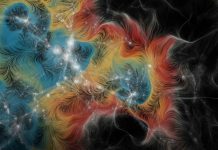
In a new study, researchers used ultrafast lasers to explore the chemistry of H3+ molecule. They observed how roaming H2 molecules evolve to H3+.
H3+ is prevalent in the universe, the Milky Way, gas giants and the Earth’s ionosphere.
The team first documented this process using methanol and they expand and duplicate this process in a number of molecules and identified a number of new pathways.
The study was done by researchers from Michigan State University.
Previously, astrochemists had observed H3+ and defined it through an interstellar perspective.
But it is extremely difficult to figure out how three chemical bonds are broken and three new ones are formed in such a short timescale.
In the current study, the team looked at the molecular level and measured the process in femtoseconds – 1 millionth of 1 billionth of a second.
The process the team viewed took between 100 and 240 femtoseconds.
Their two-laser technique showed the hydrogen transfer and the hydrogen-roaming chemistry are responsible for H3+ formation.
The researchers explain that roaming mechanisms briefly generate a neutral molecule (H2) that stays in the vicinity and extracts a third hydrogen molecule to form H3+.
In one experiment involving ethanol, the team found six potential pathways and confirmed four of them.
Because laser pulses are comparable to sound waves, the team discovered a “tune” that can enhance H3+ formation and one that discourages formation.
The team suggests these chemical reactions are the building blocks of life in the universe.
The roaming hydrogen molecules in high-energy chemical reactions involve organic molecules and organic ions and are relevant to materials irradiated with lasers.
They also are relevant to materials and tissues irradiated with x-rays, high energy electrons, positrons and more.
One study author is Professor Marcos Dantus.
Researchers from Kansas State University also contributed to the Nature Communications study. The Department of Energy and the National Science Foundation funded the work.
The new research appears in Nature Communications and the Journal of Chemical Physics.
Copyright © 2019 Knowridge Science Report. All rights reserved.



